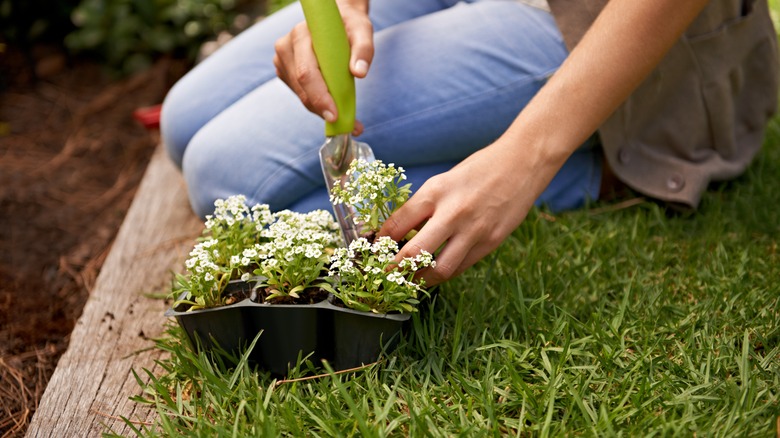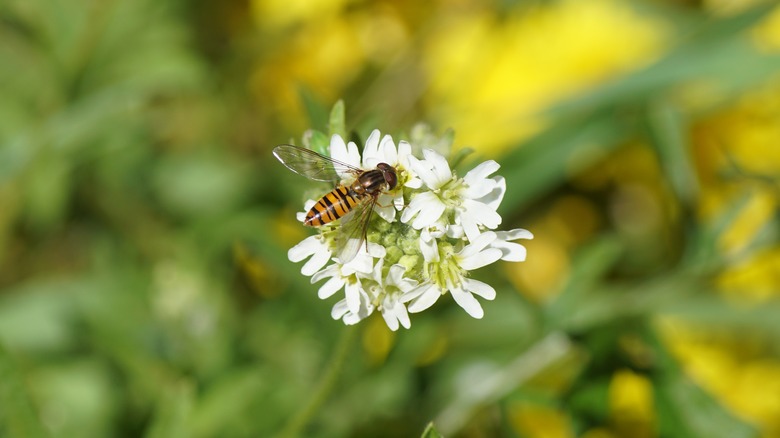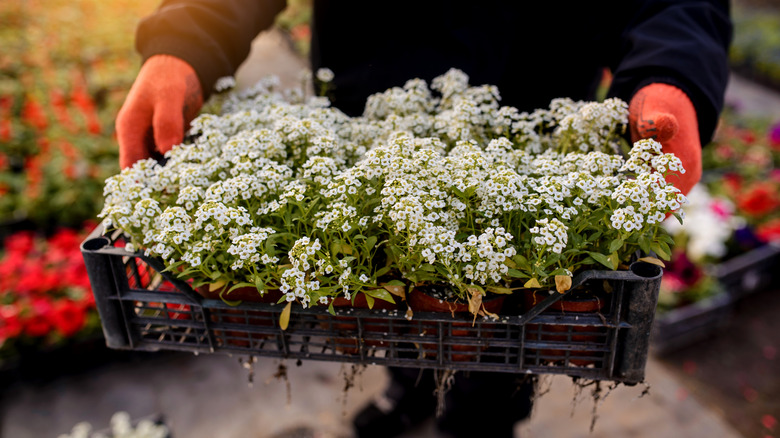Vegetables That Grow Well With Sweet Alyssum In The Garden
Sweet alyssum (Lobularia maritima) is one of the most popular companion plants for gardeners looking for organic solutions to pest problems and other common green-thumb-inhibiting issues. What is companion planting and how does it benefit your garden, you ask? Simply put, some plants help other plants thrive through various means, and companion planting involves laying out your garden in a way that maximizes these beneficial plant partnerships. In the case of sweet alyssum, this pretty warm-season annual partners well with a few key vegetables: brassica family plants like cabbages, broccoli, and kale; nightshades like potatoes, tomato, and eggplant; and a few others like zucchini, artichoke, and carrots. The plant boasts masses of spring blooms that attract beneficial insects to either pollinate the flowers or predate the pests of nearby plants — hoverflies, ladybugs, and green lacewings among them.
Sweet alyssum is a member of the cabbage and mustard (Brassicaceae) family. In fact, just like its peppery tasting cousins, it's edible! It was introduced to the U.S. from Southern Europe, and as such, thrives in USDA hardiness zones 5 to 9. Gardeners in California should note that it's listed as invasive across the state. Though it needs to be replanted each year, sweet alyssum seeds and seedlings are easily found at nurseries, big box retailers, and online sellers alike for prices unlikely to stretch even the leanest garden budget. It grows quickly, spreading out to form a living mulch that prevents erosion in your vegetable beds and blocks weeds from receiving sunlight. Vegetables in the Brassicaceae family appear to benefit most from nearby sweet alyssum plantings.
Which vegetables benefit most from sweet alyssum plantings?
Between 2018 and 2020, Australian researchers studied brassica crops bordered by sweet alyssum and found a notable increase in predators like parasitoid wasps and ladybird beetles, which prey upon pests (per Hort Innovation). Likewise, organic growers in the U.S. plant sweet alyssum next to broccoli, kale, and lettuce beds to attract syrphid flies (they like the nectar in the flowers), the larvae of which feed on brassica-loving aphids. Nurseries are quick to recommend the candy floss-like groundcover to home gardeners struggling to control voracious cabbage worms. Another brassica said to partner well with sweet alyssum is collard greens. Before rushing to your nearest garden center and buying as many sweet alyssum plants as you can fit in your trunk, a word of caution: Don't plant sweet alyssum if you're already plagued by flea beetles, harlequin bugs, or Bagrada bugs. Their host plants are predominantly brassicas; since sweet alyssum is also a brassica, it can attract more of these pests to your crops.
Brassicas aren't the only benefactors of sweet alyssum. It's also the beautiful plant that'll keep hornworms from destroying your tomatoes and eggplants since it attracts wasps that prey on them. Research indicates that aphid infestation-prone vegetables like potatoes, artichoke, and squash also benefit from the aphid-eating hoverflies (syrphid flies) the plant attracts. Though pleasant to our noses, sweet alyssum's fragrance is said to deter root-damaging carrot flies. In addition to deterring pests, planting sweet alyssum supercharges the pollinator attracting power of bean stalk flowers, and can also improve pollination for your other flowering vegetables, like zucchini. The plant's dense growth also provides a living mulch and weed barrier for potatoes.
Planting and caring for sweet alyssum in your vegetable garden
The quickest option for growing sweet alyssum is to look for ready-to-grow trays at your local nursery in early spring. Growing sweet alyssum from seed is also easy, but requires more time and effort than popping a tray of young plants in the ground. There are a surprising number of sweet alyssum cultivars to choose from. For something with demure growth but dramatic purple blooms, buy a packet of the dwarf sweet alyssum cultivar 'Royal Carpet' for about $5 from Eden Brothers. Traditionalists will love 'Snow White', a pure white Aphrodite series sweet alyssum that sells for just over $4 a packet at Pase Seeds. Sow your seeds indoors in late winter or outdoors by broadcasting as soon as the soil is workable. The best spot in your garden to plant sweet alyssum to maximize the benefits for your vegetables is interspersed between vegetable rows or as a vegetable bed border. It also does well in planters, hanging baskets, window boxes, and between stepping stones.
Mature plants can reach heights of up to 9 inches and grow to almost 50 inches wide, depending on the cultivar. Sweet alyssum is pretty much a set-and-forget kind of plant. Keep the soil in which they grow well-watered though not soggy and fertilize every month. You don't need to deadhead it (that is, remove the spent blooms), especially if you're hoping to collect the seeds or take advantage of the plant's propensity to self-seed. This hardy annual can make it through the summer in some places, but if you see truly toasty summers, your plants could really struggle or even die.


